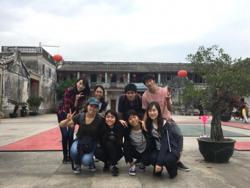International and Domestic exchange
Yuki Yoshimura (2nd year student)
Shantou Training
Day 1 (November 11)
When I arrived in Shantou, a Japanese-speaking teacher picked me up at the airport and took me to the hotel by bus. Although Japanese was not spoken on the plane, English was understood, so I did not feel much anxiety. However, I remember that I had a problem when changing planes at the airport on the way to the hotel because I could not communicate in English, so I was very relieved to meet a Japanese-speaking teacher. After arriving at the hotel, we listened to an overview of the university and hospital, and then enjoyed a welcome dinner with many of the professors and Shantou cuisine, which included delicious seafood.
Day 2 (12th)
We participated in volunteer activities in a rural district in the suburbs. In the morning, we set up a tent in the square in front of the government office and invited patients to visit us. I accompanied the visiting volunteers and saw the inside of a house and realized the living environment and economic situation of poor people in China. We also met patients who could not walk and felt the necessity of visiting them. The Chinese language spoken in the south of China is special and difficult for people from other regions to understand, and even the teacher who was leading the tour, who was translating it into Japanese, did not seem to understand it. When it was difficult to communicate with the students and rural children who had come to volunteer, we used gestures and written Chinese characters to communicate with them.
Day 3 (13th)
In the morning, we visited the medical school's collaborative laboratory, clinical skills center, and oncology hospital. The Clinical Skills Center had many dolls and medical equipment, and was well equipped to allow the students to practice their skills. At the oncology hospital, there were booths for prescribing Chinese medicine and beds in the corridors of the wards, which were very different from those in Japan and left a strong impression on me.
In the afternoon, we visited Shantou University. The campus is very large, and the library and other facilities are completely different in scale from those in Japan. The School of Medicine building, which was designed in the image of a skull, was especially unique. There is also the Museum of Human Life, which was informative with many exhibits that promoted understanding of diseases, especially lung cancer. The simulation center, with its generous use of space and recreation of the same space as a real hospital, was even better equipped for skills than the clinical skills center at the medical school. There is also a study room where students can practice their skills, and students are free to use the room if they reserve a room on the computer. I was envious that students were given many opportunities to practice outside of class.
Day 4 (14th)
We accompanied a hospice home care. The doctor listened to patients' anxieties and prescribed medicines to ease their pain. The activities were designed to improve the quality of life of the patients, and they focused not only on the illnesses such as pain and side effects of medicines, but also on mentally supporting the family, teaching the family to support the patient, and working to protect the dignity of the patient, which made me think about what a hospice should be like. It made me think about what hospice should be like.
Day 5 (15th)
We took a bus for about an hour and visited a rural hospital in the suburbs that mainly provides ophthalmology services. There were originally no hospitals in that area, and many people lost their eyesight because they could be cured by surgery but the hospitals were far away, they did not have time, or they were not able to go there economically.
Therefore, it makes a lot of sense to have a hospital where people can have surgery in a sanitary environment. There are many people who are financially unable to undergo surgery, and the Lee Ka Shing Foundation is covering part of the medical fees, etc., to considerably lighten the burden on the patients.
Day 6 (16th)
We visited the Second Affiliated Hospital of Shantou University. First, we listened to a talk about the Cleft Lip and Palate Center and actually visited a hospital room. Next, we entered the NICU. Quite a few babies were in incubators, but I was impressed by the fact that they were illuminated to prevent jaundice and that babies with infections in particular were isolated in a room with a separate door. I was also impressed by the hospital as a whole, where I saw people smoking cigarettes in the corridors and on the stairs, and by the fact that there were people adjusting the weight of the elevators as people were getting on them one after the other.
In the afternoon, we visited an ophthalmology center and a psychiatric ward.
Day 7 (17th)
We visited the Department of Obstetrics and Gynecology at the First Affiliated Hospital of Shantou University. During the outpatient examination, we were surprised to see that even when the doctor was in the middle of examining a patient, the door of the examination room was left open and the next patient was waiting for his/her turn right behind the doctor. The next patient entered the room before the previous patient was finished, and there was no privacy.
Day 8 (18th)
I took a day to return to Japan.
Studying in Shantou was a valuable experience for me to see medical care in a foreign country. I would like to express my sincere gratitude to all the doctors who gave me such a wonderful opportunity and also took time out of their busy schedule to take care of me during my study abroad.
